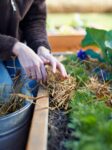
8 Essential Tips for Mulching with Straw in Your Vegetable Garden
Mulching your vegetable garden with straw has a long list of benefits. Straw is inexpensive, easy to work with, and good for your soil. A layer of straw mulch between your veggie rows sets off your plants and makes your garden look neat and tidy. Although it takes some initial effort, mulching with straw will save you time in the long run when it comes to weeding and watering. Unless you garden on a massive scale, one or two bales are usually all you’ll need to mulch your entire vegetable patch.
Here’s what you need to know about using straw mulch around your edible plants.
What Is Straw?
Straw is the dried stems left after wheat or oats (or other grains) have been harvested. Once the grain is removed, the dried stalks are bundled into bales. Ideally, there will be very few seeds or weeds in the straw bale.
Also known as pine needle mulch, pine straw is not straw but baled pine needles. It is best used for mulching ornamental beds.
Benefits of Mulching with Straw
Straw mulch suppresses weed growth. “Most annual weeds require sunlight to trigger germination and straw prevents the sunlight from reaching the soil surface so it can cut out nearly all of the annual weeds that plague us in the garden,” says North Carolina Horticulture Extension Agent Gene Fox.
Straw also moderates fluctuations in soil temperature and moisture. “A good covering of straw mulch will keep plants cooler, minimizing stress in the hotter parts of the day,” according to Fox.
Because straw reduces evaporation from the soil surface, you won’t need to water as often. Keeping the soil more evenly moist has many benefits. “Regulating moisture throughout the day is key in preventing physiological problems such as fruit cracking and even blossom end-rot in tomatoes,” says Fox.
A good layer of straw mulch helps prevent diseases that are frequently spread by splashing rain. “As the rain droplets pelt the bare soil, particles are blasted into the air and often land on the underside of leaves, spreading bacterial and fungal diseases. Organic mulch [such as straw] will dissipate the velocity of the rain droplets minimizing the soil splashing, which prevents quite a bit of disease transmission in garden plants,” says Fox.
Developing melons, pumpkins, and squash stay cleaner when resting on a straw mulch bed. It’s great for strawberries as well. “Some of my best strawberry patches are with a straw mulch between rows,” says Beth Chisholm, Whatcom County Community Garden Coordinator with the Washington State University Extension Service. “Just watch for slugs,” she adds.
How to Select Straw
Always use clean straw, not hay. Although the two may look similar, straw and hay are different in one important feature: Hay, which is grown to feed animals, contains seeds. If used as mulch, these seeds germinate and create a weed problem. A good quality straw contains few seeds. When purchasing straw, examine the bale for weeds—weedy straw will also sow weeds into the garden—exactly what you don’t want. It’s worth asking around to find a reliable source of quality straw; a local farmer, nursery, or garden center can usually help you out.
Tips for Using Straw Mulch in Your Vegetable Garden
While straw makes an excellent mulch for your vegetable garden, there are a few things to know about getting the most out of this type of mulch.
- Apply a source of nitrogen to the soil before planting. As straw breaks down, it may temporarily rob the soil of nitrogen. This is easily avoided by adding compost, well-rotted manure, worm castings, or a balanced organic fertilizer to the soil prior to planting and mulching.
- Don’t lay the mulch until your vegetables have been growing for a few weeks. Applying mulch over newly planted seeds may prevent their germination. Chisolm suggests an exception to this rule: “When seeding peas or beans, straw is a great way to protect the planting from birds robbing those newly planted seeds.” But just use a light layer of straw until the peas or beans are up and growing.
- Weed your garden before you apply your mulch. While mulch will prevent most new weed seeds from germinating, it’s important to remove existing weeds before spreading your straw.
- Apply the straw at least four to eight inches deep. Though this sounds like a lot, the straw will compress quickly, and to get maximum benefit from the mulch, you need good coverage. This insulating layer will promote beneficial microbes that help build soil. It also helps prevent erosion.
- Don’t mulch right up to the plant stem. Cover the space between rows thoroughly, but not right up to the plant stems, which can encourage fungal diseases to take hold. A good rule of thumb is to leave one to three inches of space around plant stems to provide good air circulation and avoid rots.
- Add more straw if needed during the growing season. Because straw breaks down quickly, you should check it about halfway through the growing season and add additional straw if needed to maintain good coverage. An adequately thick layer of mulch is particularly important during the heat of summer.
- Use the straw to build your soil. At the end of the growing season, straw mulch helps improve your garden soil. Fox explains, “Because it breaks down so rapidly, the straw can be turned into the soil through tillage to help fuel microbial activity. The entire process makes soils healthier and more able to produce and hold nutrients that our plants need to grow.”



